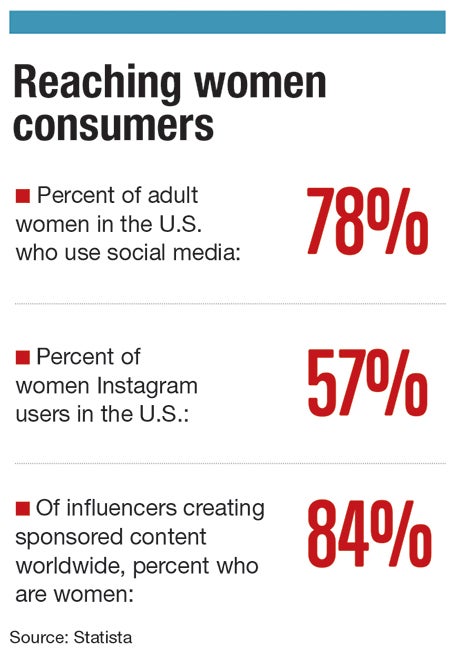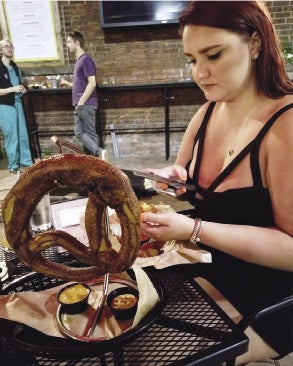If you’re part of a tech-savvy company launching a consumer-oriented product or service, one unconventional, yet increasingly popular, marketing strategy might have crossed your desk in the last several years: working with influencers to promote or review your brand on social media.
Get Instant Access to This Article
Subscribe to Worcester Business Journal and get immediate access to all of our subscriber-only content and much more.
- Critical Central Massachusetts business news updated daily.
- Immediate access to all subscriber-only content on our website.
- Bi-weekly print or digital editions of our award-winning publication.
- Special bonus issues like the WBJ Book of Lists.
- Exclusive ticket prize draws for our in-person events.
Click here to purchase a paywall bypass link for this article.
If you’re part of a tech-savvy company launching a consumer-oriented product or service, one unconventional, yet increasingly popular, marketing strategy might have crossed your desk in the last several years: working with influencers to promote or review your brand on social media.
The term’s definition is fairly obvious – an influencer being one with the power to influence – but the industry, which largely operates by way of blogs, Instagram, TikTok and other social media accounts, is a wide umbrella encompassing individuals working in fashion, beauty, fitness, politics, publishing and health, among other fields.
The practice is increasingly taking hold in Central Mass., as both influencers and firms who use them grow.
At the most basic level, when brands work with influencers, they are providing some level of compensation in exchange for access to that person’s social media followers. In other words, if an influencer has 1 million followers, you could by extension reach up to 1 million potential customers by having that influencer share your brand. In lieu of placing ads in traditional outlets, like newspapers, brands instead pay for sponsored content on an individual’s account or website.
How they share your product, what they charge, and the return on investment is bound to vary widely. Influencers may post images and text to their Instagram feed, their Instagram Stories, run sponsored content or ads on their blogs, or read messages on their podcasts. Frequently, these posts are accompanied by discount codes for followers, to incentivize them to make purchases.
“We started working with them about five years ago,” said Laura DiBenedetto, CEO of Vision Advertising in Westborough. “These relationships can be highly valuable because someone else is doing the work to expand the audience, sometimes exponentially faster than marketing on its own. But this all depends on the right partnerships.”
Notably, working with influencers can be key for companies targeting women. According to a Jan. 14 report from consumer and marketing data company Statista, 84% of Instagram users who created sponsored posts in 2019 were women. According to marketing research firm Nielsen, women are expected to be responsible for 75% of discretionary spending by 2028, worldwide.
Moreover, word-of-mouth marketing has proven to be incredibly effective. The 2015 Nielsen Global Trust in Advertising survey found 83% of consumers trust recommendations of friends and family, with 66% reporting they trust consumer opinions posted online. Influencers, frequently, fall into the latter category.
Still, investing in a relatively nascent advertising mechanism can feel risky to some business owners.
“Older demographics don’t see the value in the industry,” DiBenedetto said. “However, if this obstacle can be overcome, working with influencers can organically grow your customers base.”

A divisive term
In an increasingly Instagram-centric world, even the word influencer can be polarizing, despite how common it is to see brands and influencers working together. For some, it might evoke visions of self-centered, out-of-touch models addicted to the attention economy (the account @influencersinthewild, which posts humorous submitted videos and photos of influencers creating content in public, has become something of a household name in some circles). Others might brush influencers off as (often) beautiful people looking to make a quick dollar by capitalizing on their own relative attractiveness.
But for many, influencing is very much a full-time job, involving all of the trappings you might expect from a one-person marketing shop: client meetings, contract negotiations, hiring and working with photographers, content concept planning and proofing, copy writing and comment moderation. Many influencers also run blogs, and some use the term blogger interchangeably with influencer.
Still, those who work in the female-dominated industry often face criticism, including the accusation anyone, with enough resources, could do the job they do.

“I get that so frequently,” said CC Dryer, a newer fashion and lifestyle influencer, based in Hudson. ”Like every day. Every. Single. Day.”
Dryer, who is a year and a half into running her Instagram account, @lookatccglow, boasts just over 11,000 followers, which by most metrics makes her a micro influencer, or someone who's following has not broken past the 100,000 mark. She primarily posts about fashion and beauty, with her content centering around her daily life. Recent brands she’s worked with include blue light glasses maker Ladyboss Glasses, pretzel company Snyder's of Hanover, and skincare company Tula. Over the span of her time running @lookatccglow, she has worked with brands both local and national, she said.
Dryer started the account in 2019, after studying acupuncture at the Massachusetts College of Pharmacy and Health Sciences in Worcester.
“It was first going to be a hobby,” Dryer said. “And then, after a month of starting, I got my first collaboration, and it was with a brand from Amazon. That emailed me and said they wanted to trade product in exchange for a picture review of their items.”
As her following grew, and as her clients increased, Dryer began to view running the account, as well as her website, as a nearly full-time commitment. She leveraged her following to launch a separate business, Boss Beauty Co., which sells eyebrow products.
While she’s not yet making enough money to fully support herself financially – she does bookkeeping for her husband’s business, on the side – Dryer said many of her personal expenses are covered through her work as an influencer.
Financing life abroad
Although the idea of making a living through Instagram, blogging and other social media platforms is growing increasingly competitive – it’s not hard to search any geographic area and find low-metric accounts positioning themselves as potential, up-and-coming influencers – for those with the right combination of appealing content, algorithm savoir faire and grit, it can be a life-sustaining endeavor. It doesn’t typically happen right away, though.
Silvia Lawrence, a Worcester-native and Williams College grad living in Norway, who runs the travel blog Heart My Backpack, as well as its affiliated Instagram, Twitter, Facebook and YouTube channels (@heartmybackpack), started blogging with a friend in 2013, during a four-month backpacking trip through Central Asia. After the blog garnered a lot of attention, particularly from female travelers looking for advice planning trips through the region, Lawrence launched what would become her Heart My Backpack brand, documenting a solo backpacking trip through Iran in 2014.
“I blogged for about six months before getting a Twitter account, and a year before opening an Instagram account,” Lawrence said. “I've always been more of a writer than photographer, so blogging is the medium I'm most comfortable with.”
As with Dryer, blogging initially began as a hobby. It wasn’t until 2016, Lawrence said, she put real effort into turning Heart My Backpack into a business. (She said, however, she does know people who were able to turn their blogs into full-time income within a year of launching them.) She quit her job to run her brand full-time the following year.
The bulk of her income now comes from the blog itself, not social media. Because of this, she prefers the term blogger – although travel influencer might also be an apt descriptor, Lawrence said.
“Most people assume I make money by working with brands on sponsored campaigns, however I very rarely work on campaigns,” Lawrence said. “The bulk of my income comes from display ads on my blog, affiliate sales (where I earn a commission if someone buys a product from one of my links), and digital products like my northern lights ebook.”
Smaller, closer to home
The rates influencers and bloggers charge for sponsored content vary widely depending on a multitude of factors, including their post impression rates, follower counts and previous success translating ads into consumer dollars spent. But for some, especially those starting out, a simple in-kind payment might suffice.

Such is the case for Logan Woodcome of Worcester, the brain behind the Instagram account @ne_foodie_chick, a visual food blog. Woodcome, a medical social worker by day, started her page in 2019 following prompting from friends and family, who commented on how frequently she took and shared photos of the food she was eating, especially from area restaurants.
As it stands, Woodcome has just over 5,000 followers, and she does not charge restaurant owners for her posts, although she does sometimes trade comped meals. It’s not necessarily because she doesn’t want to monetize her platform – brands have asked her for rate charts in the past, she said – but because she doesn’t want to be a financial burden for an industry struggling to stay afloat amid the coronavirus pandemic. That could potentially change in the future, she said.

Still, even without cash payments, there is still pressure involved with promoting someone else’s company.
“I want [the posts] to look nice … so that it looks good to not only me, but also to the restaurant, and makes them look good,” Woodcome said.
At the end of the day, brand and influencer relationships are like relationships of any other kind – finding the right match, based on a variety of factors, is key.
“Don’t underestimate the value of an influencer relationship, but do your homework and due diligence,” said DiBenedetto, of Vision. “Many influencers bring a lot of value to the table, but some only look good on paper. Do your research, ask questions, and ask for references. If they are offended or unwilling to cooperate, it’s probably not the right fit.”

